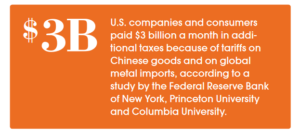With a deep understanding of your business alongside clear and honest communication, we help clients face challenges fearlessly.
Contact us today to learn more about our services and how we can help drive solutions.
The Impact of Tariffs and Their Chilling Effect On U.S. Business
November 1, 2019
The story on tariffs is a story of unintended consequences – tariffs have created additional costs for U.S. companies and some job losses to mitigate these extra costs. The current adminis-tration has imposed numerous tariffs with several of them, specifically, on consumer products and supplies that will be implemented by the end of 2019. The imposed tariffs are intended to rebalance some of the trade inequities in the market and, in general, act as a tool to incentiv-ize businesses to buy goods and supplies from companies in their home country. For instance, tariffs directed by the U.S. at China for their alleged unfair trade practices were intended to set right inequities that put U.S. companies at a disadvantage. The current administration has implemented a 25 percent tariff on steel and a 10 percent tariff on aluminum imports on a number of countries. Due to excess supply of global steel, these tariffs were largely aimed at China for their long-term practice of export-ing excess steel at low prices that have been undercutting the U.S. steel and aluminum sector, resulting in factory closures and job losses.
The chilling effect on business
In reality, the U.S. has seen an unintended chilling effect on businesses, particularly small and middle-market businesses.
The effect is felt by both businesses and their supply chains that use imported materials and by businesses that export products to other markets. This effect has been a financial hit on U.S. small businesses as a result of unraveling supply chains.
Tariff’s impact on the oil and gas market
In an already volatile oil and gas market, the tariffs on steel and aluminum have added another layer of distress to the already struggling sector.

This hefty cost increase, without any options in the U.S., has left some oilfield services providers without any viable alternatives. Businesses are working with suppliers to help share the costs, but that can only go so far. As U.S. companies are trying to relocate their supply sources to other counties, such as Vietnam, many are finding that the other countries do not have the economic management systems in place or the levels of productivity American companies are accustomed to from China
Businesses Stand Up to Tariffs
In response to the tariffs, businesses are trying to determine how to offset increased costs.
Importers often pass the costs of tariffs on to customers – manufacturers and consumers in the U.S. – by raising prices. Thus, it ends up being the final consumer that is footing the bill. Some intermediary companies are also being put in the tough financial position where the products they are importing are costing more, but their customers are refusing to accept a higher price.

The executives of large retail giants such as Target and Walmart have recently stated they will not accept the trickle down costs to their customers. This has forced companies to find ways to manage the cost increases through various strategies including accepting lower profit margins, cutting costs – including reducing wages and jobs for U.S. workers–and deferring capital expenditures. In anticipation of the tariffs, some companies imported large amounts of supplies prior to the implementation of the tariffs, which are now unused and sitting on their balance sheets.
Should the Consumer Products Sector Be Worried?
Even more new tariffs are expected to hit before the end of 2019, and largely on consumer products.
Investors are right to be concerned that retail prices will hit consumer spending, especially after the upcoming tariffs are implemented, and cause trade uncertainty that may result in making businesses hold back on capital spending. The full impact of the tariffs has yet to be realized and small and middle-market companies are going to need to get even more cre-ative to try to mitigate the increased costs.




